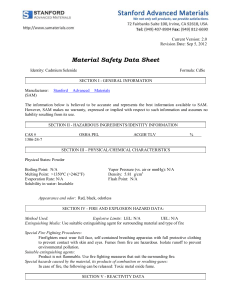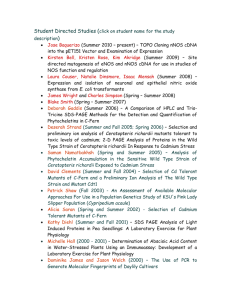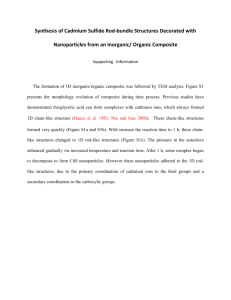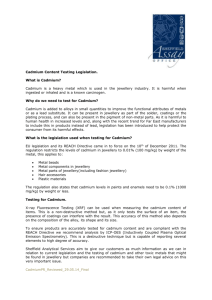C S P N
advertisement
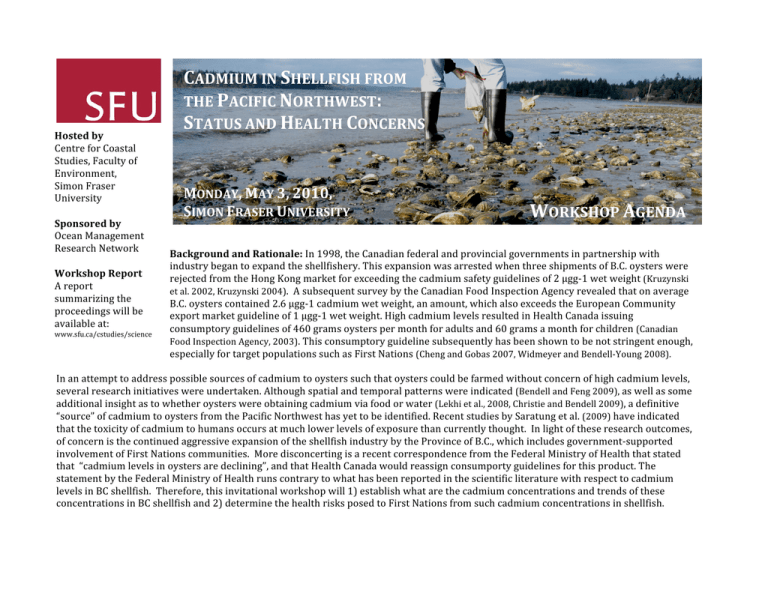
Hosted by Centre for Coastal Studies, Faculty of Environment, Simon Fraser University Sponsored by Ocean Management Research Network Workshop Report A report summarizing the proceedings will be available at: www.sfu.ca/cstudies/science CADMIUM IN SHELLFISH FROM THE PACIFIC NORTHWEST: STATUS AND HEALTH CONCERNS MONDAY, MAY 3, 2010, SIMON FRASER UNIVERSITY WORKSHOP AGENDA Background and Rationale: In 1998, the Canadian federal and provincial governments in partnership with industry began to expand the shellfishery. This expansion was arrested when three shipments of B.C. oysters were rejected from the Hong Kong market for exceeding the cadmium safety guidelines of 2 µgg‐1 wet weight (Kruzynski et al. 2002, Kruzynski 2004). A subsequent survey by the Canadian Food Inspection Agency revealed that on average B.C. oysters contained 2.6 µgg‐1 cadmium wet weight, an amount, which also exceeds the European Community export market guideline of 1 µgg‐1 wet weight. High cadmium levels resulted in Health Canada issuing consumptory guidelines of 460 grams oysters per month for adults and 60 grams a month for children (Canadian Food Inspection Agency, 2003). This consumptory guideline subsequently has been shown to be not stringent enough, especially for target populations such as First Nations (Cheng and Gobas 2007, Widmeyer and Bendell‐Young 2008). In an attempt to address possible sources of cadmium to oysters such that oysters could be farmed without concern of high cadmium levels, several research initiatives were undertaken. Although spatial and temporal patterns were indicated (Bendell and Feng 2009), as well as some additional insight as to whether oysters were obtaining cadmium via food or water (Lekhi et al., 2008, Christie and Bendell 2009), a definitive “source” of cadmium to oysters from the Pacific Northwest has yet to be identified. Recent studies by Saratung et al. (2009) have indicated that the toxicity of cadmium to humans occurs at much lower levels of exposure than currently thought. In light of these research outcomes, of concern is the continued aggressive expansion of the shellfish industry by the Province of B.C., which includes government‐supported involvement of First Nations communities. More disconcerting is a recent correspondence from the Federal Ministry of Health that stated that “cadmium levels in oysters are declining”, and that Health Canada would reassign consumporty guidelines for this product. The statement by the Federal Ministry of Health runs contrary to what has been reported in the scientific literature with respect to cadmium levels in BC shellfish. Therefore, this invitational workshop will 1) establish what are the cadmium concentrations and trends of these concentrations in BC shellfish and 2) determine the health risks posed to First Nations from such cadmium concentrations in shellfish. A G E N D A 8:30 – 9:00 9:00 – 9:15 9:15 – 9:45 9:45 – 12:00 9:45 – 10:15 10:15 – 10:45 10:45 – 11:00 11:00 – 11:30 11:30 – 12:30 11:30 – 12:00 12:00 – 12:30 12:30 – 1:15 1:15 – 1:45 1:15 – 1:45 1:45 – 4:00 2:45 – 3:00 3:30 – 4:00 Registration and light refreshment Welcome and Introduction Patricia Gallaugher; Director Centre for Coastal Studies Simon Fraser University Cadmium in Shellfish (101): A crash course in the politics of science George Kruzynski, PhD, North Saanich, BC CADMIUM CONCENTRATIONS IN SHELLFISH FROM THE PACIFIC NORTHWEST – FINDINGS FROM THREE RESEARCH PROJECTS Cadmium in Pacific Oysters (Crassostrea gigas): A survey of the United States West Coast Aimee Christy, Pacific Shellfish Institute, Olympia, Washington Cadmium in Pacific Oysters (Crassostrea gigas): A survey of the Canadian Pacific North West Coast Leah Bendell, Professor, Biological Sciences, Simon Fraser University, Burnaby Break Sources of Cadmium to BC Oysters: Field observations and isotopic tracers Kristin Orians, Professor, Earth and Ocean Sciences, University of British Columbia, Vancouver, BC UNDERSTANDING THE HEALTH RISKS How much Cadmium is Safe? Soisungwan Satarug, Visiting Research Professor, Dept. of Pathology, University of North Dakota School of Medicine & Health Sciences, Grand Forks, North Dakota (presented by George Kruzynski) Health Canada’s Past, Present and Future Roles Elizabeth Elliott, Scientific Evaluator, Chemical Health Hazard Assessment Division Lunch UNDERSTANDING THE HEALTH RISKS TO FIRST NATIONS Shellfish Safety in Coast Salish Communities Tim Kulchyski, Junior Biologist, Cowichan Tribes, Duncan ROUNDTABLE DISCUSSION ON WHAT WE HAVE LEARNED AND WHAT WE NEED TO DO NEXT Break Workshop Outcomes and Wrap­up


